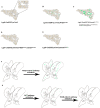PTEN-mediated AKT/β-catenin signaling enhances the proliferation and expansion of Lgr5+ hepatocytes
- PMID: 33767594
- PMCID: PMC7975694
- DOI: 10.7150/ijbs.56091
PTEN-mediated AKT/β-catenin signaling enhances the proliferation and expansion of Lgr5+ hepatocytes
Abstract
Rationale: Compelling evidence suggests that Lgr5+ hepatocytes repair liver damage by promoting the regeneration of hepatocytes and ductal cells in the case of liver injury. The PTEN-mediated AKT/β-catenin signaling plays a key role in the regulation of innate immune regulation in the liver. However, the signaling pathways that control Lgr5+ hepatocyte proliferation in the liver remain unclear. Methods: In order to assess the involvement of PTEN-mediated AKT/β-catenin signaling in the expansion of Lgr5+ hepatocytes upon liver injuries, the Lgr5-CreER; Rosa-mTmG lineage tracing system was used to target Lgr5+ hepatocytes. Results: The tracing of Lgr5+ hepatocytes showed that PTEN deletion and β-catenin activation significantly promoted the proliferation of Lgr5+ hepatocytes. In converse, the simultaneous inhibition of PTEN and β-catenin limited Lgr5+ hepatocyte proliferation in the liver. Our findings provide an insight into understanding how PTEN-mediated AKT/β-catenin signaling regulates the proliferation of Lgr5+ hepatocytes. Conclusion: The outcomes can improve the application potential of Lgr5+ hepatocytes in the treatment of liver injury diseases and provide a new treatment option for liver cancer.
Keywords: AKT/β-catenin; Lgr5; hepatocyte; liver regeneration.; proliferation.
© The author(s).
Conflict of interest statement
Competing Interests: The authors have declared that no competing interest exists.
Figures



Similar articles
-
PTEN/AKT and Wnt/β-catenin signaling pathways regulate the proliferation of Lgr5+ cells in liver cancer.Biochem Biophys Res Commun. 2023 Nov 26;683:149117. doi: 10.1016/j.bbrc.2023.10.049. Epub 2023 Oct 13. Biochem Biophys Res Commun. 2023. PMID: 37857166
-
PTEN-mediated Akt/β-catenin/Foxo1 signaling regulates innate immune responses in mouse liver ischemia/reperfusion injury.Hepatology. 2013 Jan;57(1):289-98. doi: 10.1002/hep.25958. Epub 2012 Dec 4. Hepatology. 2013. PMID: 22807038 Free PMC article.
-
Fibroblast growth factor signaling regulates the expansion of A6-expressing hepatocytes in association with AKT-dependent β-catenin activation.J Hepatol. 2014 May;60(5):1002-9. doi: 10.1016/j.jhep.2013.12.017. Epub 2013 Dec 21. J Hepatol. 2014. PMID: 24365171 Free PMC article.
-
The Conundrum of the Pericentral Hepatic Niche: WNT/-Catenin Signaling, Metabolic Zonation, and Many Open Questions.Gene Expr. 2020 Nov 11;20(2):119-124. doi: 10.3727/105221620X16007982788168. Epub 2020 Sep 22. Gene Expr. 2020. PMID: 32962796 Free PMC article. Review.
-
Liver regeneration: Cellular origin and molecular mechanisms.Liver Int. 2022 Jul;42(7):1486-1495. doi: 10.1111/liv.15174. Epub 2022 Feb 24. Liver Int. 2022. PMID: 35107210 Review.
Cited by
-
Phospholipase A2 Group IIA Is Associated with Inflammatory Hepatocellular Adenoma.Cancers (Basel). 2023 Dec 28;16(1):159. doi: 10.3390/cancers16010159. Cancers (Basel). 2023. PMID: 38201587 Free PMC article.
-
Immune Cytolytic Activity and Strategies for Therapeutic Treatment.Int J Mol Sci. 2024 Mar 23;25(7):3624. doi: 10.3390/ijms25073624. Int J Mol Sci. 2024. PMID: 38612436 Free PMC article. Review.
-
Therapeutic Potential of Natural Compounds to Modulate WNT/β-Catenin Signaling in Cancer: Current State of Art and Challenges.Int J Mol Sci. 2024 Nov 28;25(23):12804. doi: 10.3390/ijms252312804. Int J Mol Sci. 2024. PMID: 39684513 Free PMC article. Review.
-
MicroRNA Profiling of PRELI-Modulated Exosomes and Effects on Hepatic Cancer Stem Cells.Int J Mol Sci. 2024 Dec 11;25(24):13299. doi: 10.3390/ijms252413299. Int J Mol Sci. 2024. PMID: 39769068 Free PMC article.
-
Genetic evidence strengthens the connection between gut microbiota and gingivitis: a two-sample Mendelian randomization study.Front Cell Infect Microbiol. 2024 May 15;14:1380209. doi: 10.3389/fcimb.2024.1380209. eCollection 2024. Front Cell Infect Microbiol. 2024. PMID: 38812751 Free PMC article.
References
-
- Sato T, Vries RG, Snippert HJ, van de Wetering M, Barker N, Stange DE. et al. Single Lgr5 stem cells build crypt-villus structures in vitro without a mesenchymal niche. Nature. 2009;459:262–U147. - PubMed
-
- Metcalfe C, Kljavin NM, Ybarra R, de Sauvage FJ. Lgr5(+) Stem Cells Are Indispensable for Radiation-Induced Intestinal Regeneration. Cell Stem Cell. 2014;14:149–59. - PubMed
-
- Garcia MI, Ghiani M, Lefort A, Libert F, Strollo S, Vassart G. LGR5 deficiency deregulates Wnt signaling and leads to precocious Paneth cell differentiation in the fetal intestine. Dev Biol. 2009;331:58–67. - PubMed
-
- Kemper K, Prasetyanti PR, De Lau W, Rodermond H, Clevers H, Medema JP. Monoclonal Antibodies Against Lgr5 Identify Human Colorectal Cancer Stem Cells. Stem Cells. 2012;30:2378–86. - PubMed
-
- Schepers AG, Snippert HJ, Stange DE, van den Born M, van Es JH, van de Wetering M. et al. Lineage Tracing Reveals Lgr5(+) Stem Cell Activity in Mouse Intestinal Adenomas. Science. 2012;337:730–5. - PubMed
MeSH terms
Substances
LinkOut - more resources
Full Text Sources
Other Literature Sources
Research Materials

